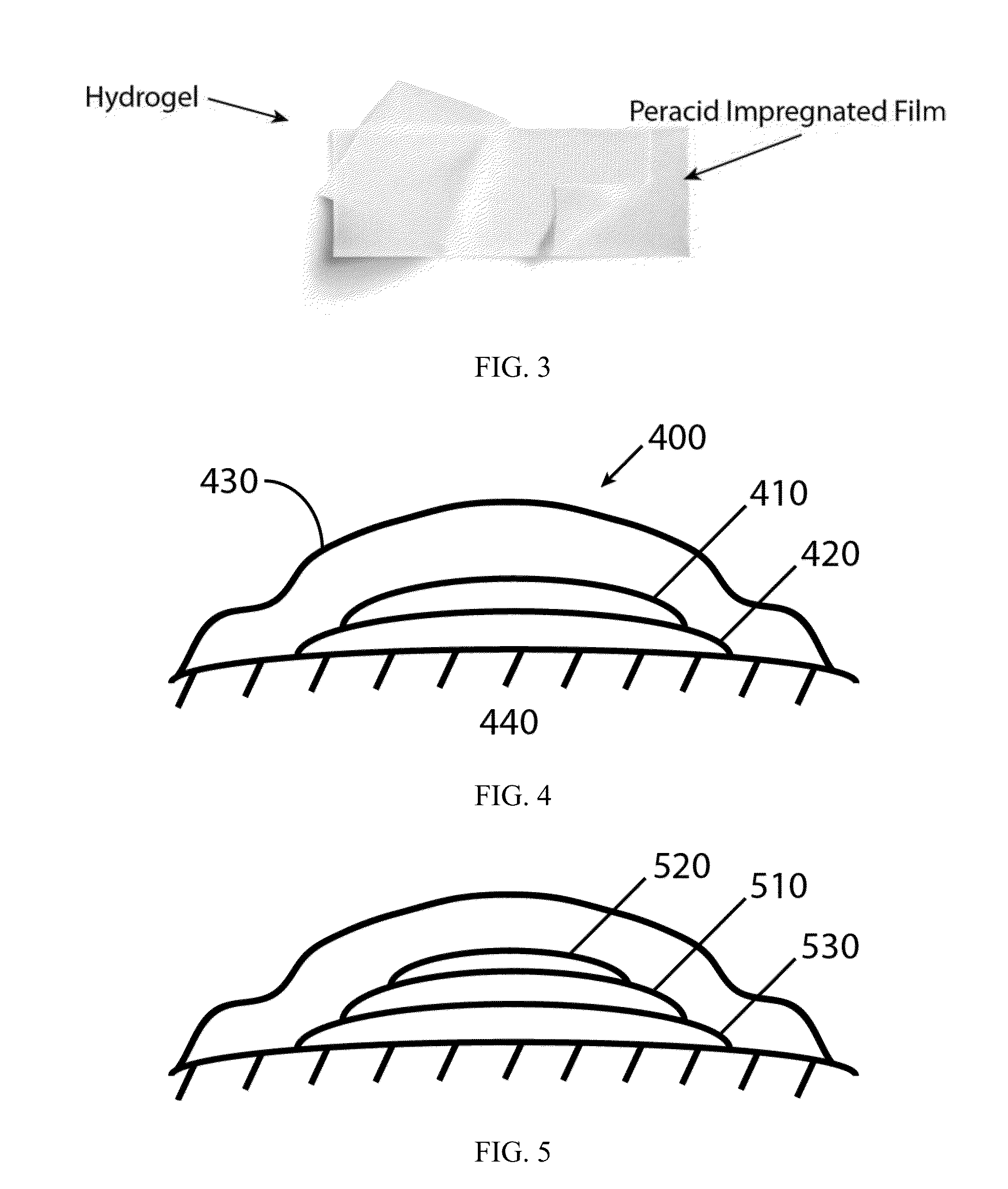Wound Care Products with Peracid Compositions
a technology of peracid composition and wound care products, applied in the field of wound care products with peracid composition, can solve the problems of significant morbidity and treatment costs, complications, and possible formation of chronic wounds, and achieve the effect of eliminating microbial infections and favorable impacting wound healing
- Summary
- Abstract
- Description
- Claims
- Application Information
AI Technical Summary
Benefits of technology
Problems solved by technology
Method used
Image
Examples
example 1
Dissolving Thin Film Formulation
[0090]In one embodiment, the film dissolves upon contact with a fluid, e.g., water from matrix such as a hydrogel, or fluids that are released from the treatment site.
[0091]The film may be comprised of a dissolvable hydrocolloid such as pullulan. The film may be comprised of one or more layers, any of which may be comprised further of an emulsifying agent, a solubilizing agent, a wetting agent, a taste modifying agent, a plasticizer, an active agent, a water soluble inert filler, a preservative, a buffering agent, a coloring agent, a stabilizer, or a combination thereof.
[0092]Formulations for the dissolvable layer may include: (1) fast-dissolving film component such as pullulan, generally 10-95% wt. %, (2) a plasticizer for flexibility such as λ-carrageenan, generally 0.05-35% wt. %, (3) a dissolution modulating agent (e.g. hydroxymethycellulose), generally 0.1%-10%, and (4) a surfactant, for dispersion, such as polysorbate A at 0.001-0.1%. The initia...
example 2
Hydrogel—Dissolvable Film Multi-Layer Composition
[0096]A PVA hydrogel layer was prepared with 10% PVA (wt. / wt.) mixed and heated at 95° C., allowed to cool, and then poured onto a glass plate with Teflon spacer (about 2.5 mm) to a size of 13×13×0.25 cm. Another glass plate was positioned on top and the two plates were clamped together with medium paper binder clips. The entire assembly was then wrapped in non-stick aluminum foil and subjected to one freeze-thaw cycle. In one embodiment, repeated cycles of freezing and thawing of polymer solution result in solids exclusion forcing polymer units in proximity with one another, probably through Van der Waals attractions, and possibly through ionic bonding, which leads to the generation of solid hydrogel. Preferably, the polymer is frozen at less than −20° C. for 10 to 20 hours, where cyclic freeze-thaws result in tighter bonding, which in turn allows one to vary the pore size in order to control the rates of dissolution of materials fro...
example 3
Preparation of a Thin Rapidly Dissolving Film
[0097]Formulations for the dissolvable layer may include: (1) Fast-dissolving film component such as pullulan, generally 10-95% wt. %, (2) a plasticizer for flexibility such as beta-carrageenan, generally 0.05-35% wt %, (3) a dissolution modulating agent (e.g. hydroxymethycellulose), generally 0.1%-10%, and (4) a surfactant, for dispersion, such as polysorbate A at 0.001-0.1%. The initial preparation is mixed in deionized water along with the peracid composition at its desired concentration (100 ppm to 10,000 ppm) and cast. Final residual water content is generally 1-4% depending on method of casting and extent of drying.
[0098]An occlusive membrane, aluminized mylar, with an adhesive backing is typically applied over the matrix.
[0099]The two components may be assembled just prior to application or while on the wound site whereby the dry film is applied to the top of the hydrogel which is placed in contact with the wound.
[0100]Alternativel...
PUM
| Property | Measurement | Unit |
|---|---|---|
| thicknesses | aaaaa | aaaaa |
| size | aaaaa | aaaaa |
| size | aaaaa | aaaaa |
Abstract
Description
Claims
Application Information
 Login to View More
Login to View More - R&D
- Intellectual Property
- Life Sciences
- Materials
- Tech Scout
- Unparalleled Data Quality
- Higher Quality Content
- 60% Fewer Hallucinations
Browse by: Latest US Patents, China's latest patents, Technical Efficacy Thesaurus, Application Domain, Technology Topic, Popular Technical Reports.
© 2025 PatSnap. All rights reserved.Legal|Privacy policy|Modern Slavery Act Transparency Statement|Sitemap|About US| Contact US: help@patsnap.com



